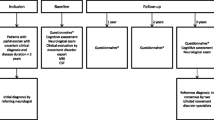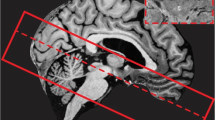Abstract
The aim of this study was to investigate newly diagnosed patients with Parkinson’s disease (PD) with structural magnetic resonance imaging (MRI), to compare them with healthy controls, to relate the findings to clinical subtypes—tremor dominant (TD) or postural instability and gait difficulty (PIGD)—and to investigate the relationship between both the duration from onset of symptoms to diagnosis and the severity of symptoms and the MRI findings. Patients with a definite PD diagnosis were compared to patients with a probable PD diagnosis. We hypothesized that the PIGD subtype, the probable PD group, a greater symptom severity and a longer symptom duration would all be associated with more frequent pathological findings. Sixty-six PD patients were included and examined with MRI, 35 with the PIGD subtype and 23 with the TD subtype. Fifty-three had definite PD and 13 probable PD. Thirty healthy individuals, matched for age and sex, served as controls. Degenerative changes in the cerebellar cortex and the superior cerebellar peduncle were significantly more common in the probable PD group than in the controls, suggesting the possibility of an emerging atypical parkinsonian disorder. No significant MRI differences were found between definite PD and controls, between definite PD and probable PD, nor between PIGD and TD. No significant associations were found between duration to diagnosis and MRI results, nor between severity of symptoms and MRI results. Thus, although pathological MRI findings were common they can not be used to separate subgroups of PD in newly diagnosed patients.

Similar content being viewed by others
References
Acharya HJ, Bouchard TP, Emery DJ, Camicioli RM (2007) Axial signs and magnetic resonance imaging correlates in Parkinson’s disease. Can J Neurol Sci 34:56–61
Alves G, Larsen JP, Emre M, Wentzel-Larsen T, Aarsland D (2006) Changes in motor subtype and risk for incident dementia in Parkinson’s disease. Mov Disord 21:1123–1130. doi:10.1002/mds.20897
Benamer TS, Patterson J, Grosset DG, Booij J, de Bruin K, van Royen E, Speelman JD, Horstink MH, Sips HJ, Dierckx RA, Versijpt J, Decoo D, Van Der Linden C, Hadley DM, Doder M, Lees AJ, Costa DC, Gacinovic S, Oertel WH, Pogarell O, Hoeffken H, Joseph K, Tatsch K, Schwarz J, Ries V (2000) Accurate differentiation of parkinsonism and essential tremor using visual assessment of [123I]-FP-CIT SPECT imaging: the [123I]-FP-CIT study group. Mov Disord 15:503–510. doi:10.1002/1531-8257(200005)15:3<503::AID-MDS1013>3.0.CO;2-V
Bhattacharya K, Saadia D, Eisenkraft B, Yahr M, Olanow W, Drayer B, Kaufmann H (2002) Brain magnetic resonance imaging in multiple-system atrophy and Parkinson disease: a diagnostic algorithm. Arch Neurol 59:835–842. doi:10.1001/archneur.59.5.835
Burton EJ, McKeith IG, Burn DJ, Williams ED, JT OB (2004) Cerebral atrophy in Parkinson’s disease with and without dementia: a comparison with Alzheimer’s disease, dementia with Lewy bodies and controls. Brain 127:791–800. doi:10.1093/brain/awh088
de Lau LM, Giesbergen PC, de Rijk MC, Hofman A, Koudstaal PJ, Breteler MM (2004) Incidence of parkinsonism and Parkinson disease in a general population: the Rotterdam Study. Neurology 63:1240–1244
Gibb WR, Lees AJ (1988) The relevance of the Lewy body to the pathogenesis of idiopathic Parkinson’s disease. J Neurol Neurosurg Psychiatry 51:745–752. doi:10.1136/jnnp.51.6.745
Gilman S, Low PA, Quinn N, Albanese A, Ben-Shlomo Y, Fowler CJ, Kaufmann H, Klockgether T, Lang AE, Lantos PL, Litvan I, Mathias CJ, Oliver E, Robertson D, Schatz I, Wenning GK (1999) Consensus statement on the diagnosis of multiple system atrophy. J Neurol Sci 163:94–98. doi:10.1016/S0022-510X(98)00304-9
Gundersen HJ, Jensen EB (1987) The efficiency of systematic sampling in stereology and its prediction. J Microsc 147:229–263
Hutchinson M, Raff U (2008) Detection of Parkinson’s disease by MRI: spin-lattice distribution imaging. Mov Disord 23:1991–1997. doi:10.1002/mds.22210
Kato N, Arai K, Hattori T (2003) Study of the rostral midbrain atrophy in progressive supranuclear palsy. J Neurol Sci 210:57–60. doi:10.1016/S0022-510X(03)00014-5
Katzenschlager R, Cardozo A, Avila Cobo MR, Tolosa E, Lees AJ (2003) Unclassifiable parkinsonism in two European tertiary referral centres for movement disorders. Mov Disord 18:1123–1131. doi:10.1002/mds.10523
Lee EA, Cho HI, Kim SS, Lee WY (2004) Comparison of magnetic resonance imaging in subtypes of multiple system atrophy. Parkinsonism Relat Disord 10:363–368. doi:10.1016/j.parkreldis.2004.04.008
Litvan I, Agid Y, Calne D, Campbell G, Dubois B, Duvoisin RC, Goetz CG, Golbe LI, Grafman J, Growdon JH, Hallett M, Jankovic J, Quinn NP, Tolosa E, Zee DS (1996) Clinical research criteria for the diagnosis of progressive supranuclear palsy (Steele-Richardson-Olszewski syndrome): report of the NINDS-SPSP international workshop. Neurology 47:1–9
Litvan I, Bhatia KP, Burn DJ, Goetz CG, Lang AE, McKeith I, Quinn N, Sethi KD, Shults C, Wenning GK (2003) Movement Disorders Society Scientific Issues Committee report: SIC Task Force appraisal of clinical diagnostic criteria for Parkinsonian disorders. Mov Disord 18:467–486. doi:10.1002/mds.10459
Marshall VL, Patterson J, Hadley DM, Grosset KA, Grosset DG (2006) Two-year follow-up in 150 consecutive cases with normal dopamine transporter imaging. Nucl Med Commun 27:933–937. doi:10.1097/01.mnm.0000243374.11260.5b
Minati L, Grisoli M, Carella F, De Simone T, Bruzzone MG, Savoiardo M (2007) Imaging degeneration of the substantia nigra in Parkinson disease with inversion-recovery MR imaging. AJNR Am J Neuroradiol 28:309–313
Ngandu T, von Strauss E, Helkala EL, Winblad B, Nissinen A, Tuomilehto J, Soininen H, Kivipelto M (2007) Education and dementia: what lies behind the association? Neurology 69:1442–1450. doi:10.1212/01.wnl.0000277456.29440.16
Nicoletti G, Lodi R, Condino F, Tonon C, Fera F, Malucelli E, Manners D, Zappia M, Morgante L, Barone P, Barbiroli B, Quattrone A (2006) Apparent diffusion coefficient measurements of the middle cerebellar peduncle differentiate the Parkinson variant of MSA from Parkinson’s disease and progressive supranuclear palsy. Brain 129:2679–2687. doi:10.1093/brain/awl166
Paviour DC, Price SL, Jahanshahi M, Lees AJ, Fox NC (2006) Regional brain volumes distinguish PSP, MSA-P, and PD: MRI-based clinico-radiological correlations. Mov Disord 21:989–996. doi:10.1002/mds.20877
Paviour DC, Price SL, Stevens JM, Lees AJ, Fox NC (2005) Quantitative MRI measurement of superior cerebellar peduncle in progressive supranuclear palsy. Neurology 64:675–679
Price S, Paviour D, Scahill R, Stevens J, Rossor M, Lees A, Fox N (2004) Voxel-based morphometry detects patterns of atrophy that help differentiate progressive supranuclear palsy and Parkinson’s disease. Neuroimage 23:663–669. doi:10.1016/j.neuroimage.2004.06.013
Righini A, Antonini A, De Notaris R, Bianchini E, Meucci N, Sacilotto G, Canesi M, De Gaspari D, Triulzi F, Pezzoli G (2004) MR imaging of the superior profile of the midbrain: differential diagnosis between progressive supranuclear palsy and Parkinson disease. AJNR Am J Neuroradiol 25:927–932
Savoiardo M (2003) Differential diagnosis of Parkinson’s disease and atypical parkinsonian disorders by magnetic resonance imaging. Neurol Sci 24(Suppl 1):S35–S37. doi:10.1007/s100720300036
Schulz JB, Skalej M, Wedekind D, Luft AR, Abele M, Voigt K, Dichgans J, Klockgether T (1999) Magnetic resonance imaging-based volumetry differentiates idiopathic Parkinson’s syndrome from multiple system atrophy and progressive supranuclear palsy. Ann Neurol 45:65–74. doi:10.1002/1531-8249(199901)45:1<65::AID-ART12>3.0.CO;2-1
Seppi K, Schocke MF (2005) An update on conventional and advanced magnetic resonance imaging techniques in the differential diagnosis of neurodegenerative parkinsonism. Curr Opin Neurol 18:370–375. doi:10.1097/01.wco.0000173141.74137.63
Seppi K, Schocke MF, Wenning GK, Poewe W (2005) How to diagnose MSA early: the role of magnetic resonance imaging. J Neural Transm 112:1625–1634. doi:10.1007/s00702-005-0332-2
Taylor KS, Counsell CE, Harris CE, Gordon JC, Smith WC (2006) Pilot study of the incidence and prognosis of degenerative Parkinsonian disorders in Aberdeen, United Kingdom: methods and preliminary results. Mov Disord 21:976–982. doi:10.1002/mds.20866
Van Den Eeden SK, Tanner CM, Bernstein AL, Fross RD, Leimpeter A, Bloch DA, Nelson LM (2003) Incidence of Parkinson’s disease: variation by age, gender, and race/ethnicity. Am J Epidemiol 157:1015–1022. doi:10.1093/aje/kwg068
Watanabe H, Fukatsu H, Katsuno M, Sugiura M, Hamada K, Okada Y, Hirayama M, Ishigaki T, Sobue G (2004) Multiple regional 1H-MR spectroscopy in multiple system atrophy: NAA/Cr reduction in pontine base as a valuable diagnostic marker. J Neurol Neurosurg Psychiatry 75:103–109
Yekhlef F, Ballan G, Macia F, Delmer O, Sourgen C, Tison F (2003) Routine MRI for the differential diagnosis of Parkinson’s disease, MSA, PSP, and CBD. J Neural Transm 110:151–169. doi:10.1007/s00702-002-0785-5
Acknowledgments
This study was supported by grants from The Swedish Medical Research Council, The Parkinson Foundation in Sweden, The Swedish Association of Persons with Neurological Disabilities, The University of Umeå, the Foundation for Clinical Neuroscience at Umeå University Hospital, Västerbotten County Council (ALF) and King Gustaf V’s and Queen Victoria’s foundation.
Author information
Authors and Affiliations
Corresponding author
Rights and permissions
About this article
Cite this article
Linder, J., Birgander, R., Olsson, I. et al. Degenerative changes were common in brain magnetic resonance imaging in patients with newly diagnosed Parkinson’s disease in a population-based cohort. J Neurol 256, 1671–1680 (2009). https://doi.org/10.1007/s00415-009-5177-4
Received:
Revised:
Accepted:
Published:
Issue Date:
DOI: https://doi.org/10.1007/s00415-009-5177-4




